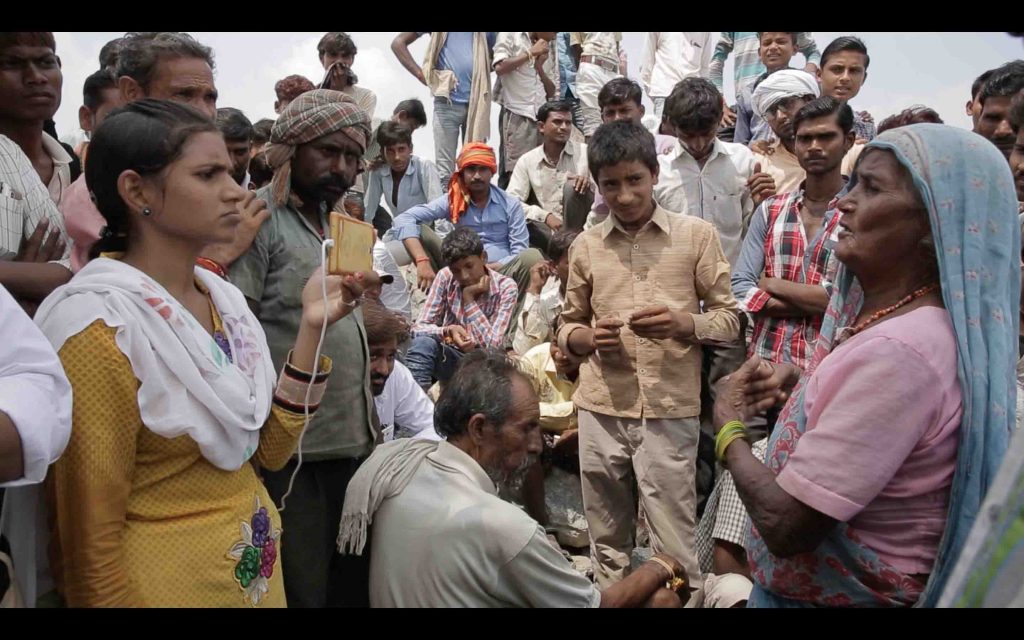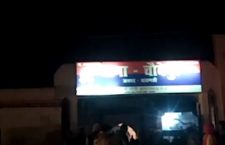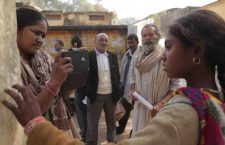Interview by Clara-Laeila Laudette of Logically with Khabar Lahariya’s Digital Head Kavita Devi, and Pooja Pande, its head of Partnerships.
How did the idea to hire, not just rural women, but Dalit women as reporters come about?
There’s this concept of the ‘Lakshman Reha’, which is a boundary women aren’t expected to cross. It’s an ideological reference from the Ramayana, with very deep cultural resonance. You’re in a box, and you see women in just that box.
There were certain areas where women could be seen, where it was okay to be, but journalism definitely wasn’t one of them. We wanted to disrupt the idea of who is a legitimate news-maker, and what “news” meant to people in rural areas and small towns.
How did you select and train your first local reporters?
Women in rural areas didn’t know the meaning of reporting. Even if a woman ever accessed a newspaper it never connected with her life; it had no relevance. Our first stumbling block was that people had no initial connection with journalism to build on. We had to start from nothing.
I tapped into personal networks built during the community-based Neo-Literacy programme. That was how we started. We went around this network, speaking to women in villages about news. Ordinary women would ask us what it meant—because we looked like them yet were working, and they wanted to do the same. Women were intrigued, asked: “What does ‘journalist’ even mean? How come you’re working in a paper?”
How do caste and class impact KL’s mission?
Here, women are considered soft. Journalism is a hard profession, and no place for a woman.
We launched in 2002 as a print paper in Uttar Pradesh. There, the idea of the news-maker was always that of an upper-caste man. Khabar Lahariya [KL] came to disrupt that idea by training Dalit women, Adivasi women, and women attended the Neo-Literacy program. Those women formed the core group. They came together and decided to do something with the new tools—their new literacy skills.
What were some of the chief obstacles or fears for the budding woman reporter?
There’s a tradition called ghoonghat where women cover their heads with their saree in certain places, in front of men or older women, as a sign of respect. These are the traditions that they’re coming from. So there were too many firsts: a woman actually had to lift that veil because you know, you can’t go around reporting [veiled]. She had to go into crowded areas. Again, another first for her.
And one of the biggest firsts was talking to men. So if you’re reporting from a crowded area where there’s been an accident, there will be 20 men—and you’re going to interview some of them. It represented too many firsts clustered together.
It’s a constant struggle. Going out, talking to men, irregular hours: families and in-laws opposed all this. In fact, family pressures, resistance to this uncharted territory made retaining reporters a huge challenge. Everyone piles onto the women, asking ‘Where have you been?’.
On average, five out of every 15 women we trained would stay. A key drop-off point was after the first week of training, during the first on-field outing. And now that KL is credible and popular we take the initiative to fire women if we feel motivation’s wanting.
Did you ever feel KL was in danger?
KL is the only indie and hyper-local news channel of its kind. Our reporters have full-time salaries, which makes sustainability difficult.
I feel very personally about this job; it’s linked to my identity. Threats to KL rattle me deeply, and many other employees too. Financial independence is very important for us women, as we’re often running our own homes, caring for kids… Divorce is both a freedom and a hardship.
What are the biggest challenges for rural communities in accessing reliable information online?
There isn’t sufficient coverage of local news, and people have a fixed idea of what news is: something that happens in cities.
Uttar Pradesh hasn’t got great literacy—let alone news literacy. So awareness [of what constitutes quality news] isn’t very high. People rarely recognise propaganda.
Misinformation comes especially from WhatsApp, which is the biggest medium over there. And it works because it talks into the existing mindset. That’s what makes it almost impossible to shake off, and very few can recognise it.
What’s KL’s take on the situation with Whatsapp and misinformation?
We think it’s an extraordinarily important, complex issue, and we’re delighted to be brainstorming at the heart of it. We see the relationship between Whatsapp and misinformation around traditional Indian events. For festivals like Naaga Pujaa, people actually believe the holy snakes drink the milk.
Look at Kumbh Mela, which has taken on superstar proportions here. It’s a traditional religious ritual, repurposed by Hindu nationalism. Social media contributes to this, including Facebook.
During celebrations, pictures went viral: a city with golden domes, everything gold, supposedly here in Allahabad. It was used to encourage Hindu pride, Hindu nationalism—and the pictures were forwarded with messages like “Be proud to be Hindu, proud to be Indian”.
The photos actually show a city in Saudi Arabia, but no one in local and rural news cares about not spreading fake news. Nobody’s interested in getting to the source. KL reporters are very invested in misinformation, which most frequently presents as propaganda. We see connections in the increase of political propaganda and misinformation messages.
Getting people interested in misinformation is a high concern ahead of the election. What’s missing are the tools and exposure (like awareness drives). When the right mechanisms and knowledge aren’t invested rurally, how can you get people to care?
How would you describe KL?
Trend-setting; provocative. Path-breaking, challenging. Revolutionary and uplifting. It’s my passion.
How has becoming a KL journalist impacted your life?
It’s been completely transformative. I was married at 12 years old. Now [as chief editor] I deal with an innumerable number of men. I’m head of the house.
My own health was never a priority in my life, because women are told to prioritise others. But the personal is political—the sindhoor, the mangal sootar, the bangles, the clothing… All of these symbolise married women. Choosing when and where to wear certain things was huge for me. It might seem small to you, but those moments felt revolutionary.
Mobility is the crux of it all. I went from barely leaving my house to moving around constantly. In communities, I’m no longer known as someone’s daughter or wife, but as ‘Kavita of KL’.
How can people with radically opposed viewpoints enter into dialogue?
India’s political climate has really seen polarisation intensify. What was formerly just religious polarisation is now also caste-based. So, Hindus versus Dalits. Look at the legacies of Ambedkar Vadi: the politicisation of identity has spawned huge mobilisation.
People have very violent arguments, both online and offline. We believe KL should be spearheading this conversation—this revolution. We’re debating exactly how; very actively working out strategies. Some solutions could be awareness drives, locally, but it’s a complex issue to cover in one day. Global strategies might not work for hyperlocal audiences.
How class-segregated is news consumption in India?
The politics of knowledge production centre around class, caste, and language. What’s shocking is that digital media replicates and validates this system.
So who is a legitimate newsmaker? A legitimate opinion-giver? There are centuries of systemic distancing to deal with. With the message being: “What you think concerns you isn’t newsworthy.”
What are the unique traits of the Indian news ecosystem?
The entire ecosystem is set up to maintain the status quo, which is well understood and deeply entrenched—even in new digital media. So even if you see a Dalit reporter, they’ll be male and upper-class.
This model works against KL. But now, we’ve reached a point where national newsmakers want to know what KL’s take on the elections is. That’s huge.
Attention around KL is growing, and our videos are exploding on YouTube. So hopefully this will all really, really change for the better.
Click here to read the Logically interview; re-posted with permission.


